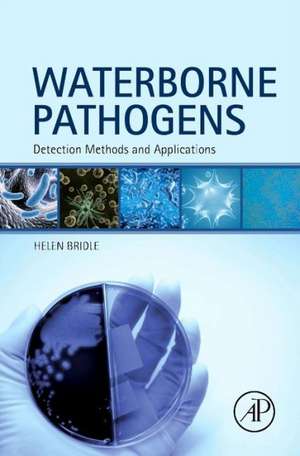Waterborne Pathogens: Detection Methods and Applications
Editat de Helen Bridleen Limba Engleză Hardback – 23 iul 2013
- Covers the gap of specific sound methods of pathogen detection by fulfulling the need for a concept book on the novel technologies for pathogen detection in water
- Presents all cutting-edge technologies for pathogen detection in water as well as recent emerging technologies
- Addresses all three types of pathogens; this combined knowledge helps to understand all potential pathogens in water
Preț: 836.14 lei
Preț vechi: 1145.39 lei
-27% Nou
Puncte Express: 1254
Preț estimativ în valută:
159.99€ • 174.34$ • 134.82£
159.99€ • 174.34$ • 134.82£
Carte tipărită la comandă
Livrare economică 24 aprilie-08 mai
Preluare comenzi: 021 569.72.76
Specificații
ISBN-13: 9780444595430
ISBN-10: 0444595430
Pagini: 416
Dimensiuni: 152 x 229 x 25 mm
Greutate: 0.79 kg
Editura: Elsevier LTD, Oxford
ISBN-10: 0444595430
Pagini: 416
Dimensiuni: 152 x 229 x 25 mm
Greutate: 0.79 kg
Editura: Elsevier LTD, Oxford
Public țintă
Microbiologists, Immunologists, medical and public health professionals, civil and environmental engineers, regulators and managers involved with water quality and monitoring, water utilities, equipment manufacturers, policy and government officials, graduate students and postdoctoral scientists.Cuprins
1. Introduction2. Overview of Waterborne Pathogens3. Existing Methods of Detection4. Methods of Sample Concentration and Enrichment5. Optical Detection Technologies for Waterborne Pathogens 6. Electrical Methods to Detect Waterborne Pathogens7. Biosensors for the Detection of Waterborne Pathogens8. Application of Molecular Methods to Detect Waterborne Pathogens 9. Potential of Nanotechnology to Enhance Detection10. Role of Microfluidic Lab-on-a-Chip Systems for Waterborne Pathogen Detection11. Application of Emerging Technologies in the Drinking Water Sector12. Conclusions
Recenzii
"Access to clean water is one of the central problems of the modern civilization, and this volume concentrates on one of its crucial aspects: identification, detection, and classification of waterborne pathogens. Covering both theoretical and practical ground, several biological chemists and professionals address the problems inherent in this field." --ProtoView.com, January 2014
“The major strength is the coverage of all three types of pathogens found in water and together in the same book as descriptions of the new technologies that are being investigated as potential improvements to current methods. --Kimberley Gilbride, Biology Program Director, Ryerson University
“The major strength is the coverage of all three types of pathogens found in water and together in the same book as descriptions of the new technologies that are being investigated as potential improvements to current methods. --Kimberley Gilbride, Biology Program Director, Ryerson University
